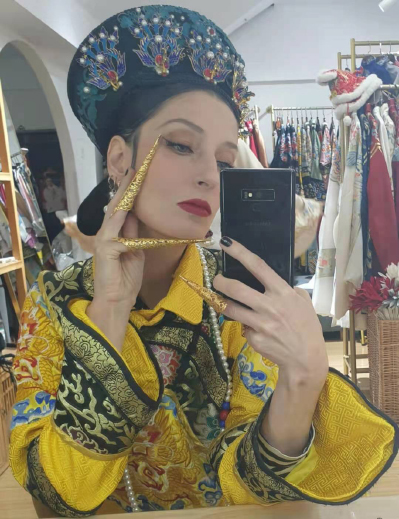| Lifestyle |
| Nailing the test of time | |
|
|
 The author takes a selfie all decked out in Qing Dynasty (1644-1911) empress style, nail guards included (ELSBETH VAN PARIDON)
Every so often, a Chinese fashion icon unwittingly flipped the fashion slash beauty landscape upside down. This time, we unearth the imperial tomb of China's Empress Dowager Cixi (1835-1908). And her spiking passion for swanky nails. They say you're not rich until you have something money can't buy. The upper-class ladies of ancient China would concur: long nails weren't for sale. The natural outcome was to stretch the canvas. And so nails grew. Colors were spilled, sparkles were deployed. The confines of a nail couldn't deter the Chinese people's raging creativity and desire for social display. Ancient Chinese nobles started growing long nails during the Warring States Period (475-221 B.C.) to show that they weren't manual laborers, but it wasn't until the Ming Dynasty (1368-1644) that long nails and nail guards became a prominent symbol of material prosperity. Given long nails could easily cause harm and get harmed, the longer the nails, the more "impaired" the wearer, the more servants required, and the more fortune drained. Oh, the cost it takes to flaunt wealth! The long nail trend reached its peak in the Qing Dynasty (1644-1911), with Cixi as its poster woman. The Marie Antoinette of the East, her beauty hacks and fashion choices were to be revered and replicated where possible. Cixi nurtured a nail length of roughly 20 cm on her ring and pinky fingers and cocooned them in gem-laden, colorful nail guards. During the day, Cixi usually wore nail guards made of gold or silver. According to the memoirs of her maid, before bed, she would switch them into nail pockets made of bright yellow (the color reserved for Chinese emperors and empresses) satin, presumably in a motherly manner akin to tucking her nail babies into their sleeping bags. Arguably one of the most iconic accessories of the Qing royals, the nail guard had purposes beyond accessorizing. The humble origins of nail guards began in the Han Dynasty (202 B.C.-A.D. 220), more than a millennium prior to their mainstream glory. At that time, they weren't particularly decorative. It wasn't until the Qing Dynasty that they became as delicate and flamboyant as people today know them to have been. Since nail guards were a social signal, the more complex their design, the higher up the concubine wearing them was on the royal ladder. Common design patterns included plants, flowers, and calligraphy art. Cixi, on the other hand, had exclusive rights to dragon and phoenix carvings on her nail guards. Needless to say, she didn't skimp on exercising these rights. Nail guards had very diverse looks. They could be made of gold, silver, bronze, jade, gilded metal, vitreous enamel, hawksbill sea turtle shells, or cloisonné, usually inlayed with gemstones, glass, and kingfisher feathers. Their ends could be rounded or sharp. Long nails may no longer be front and center on the vogue stage. Yet the icon status of period drama series like Empresses in the Palace (2011), Ruyi's Royal Love in the Palace (2018), and Story of Yanxi Palace (2018) ushered in the dominance of the Morandi color palette in China's nail art circle. Inspired by Italian painter Giorgio Morandi, the manicure industry today also adopts a more subdued color scheme that gives off a feeling of balance and elegance. Nobody is putting the nail in the coffin anytime soon. The author is an editorial consultant with Beijing Review Comments to dingying@cicgamericas.com |
|
||||||||||||||||||||||||||||||
|